The Camry 40, which corresponds to the European middle-class D, began production in 2006. The cars were equipped with several types of engines, but customers were offered only sedan-type body.
Dimensions and capacity of the Camry 40
 The passenger car is equipped with 4 hinged doors, the interior provides separate front seats for the driver and passenger. Rear sofa is designed for 3 people, but in the central part of the back is a folding armrest, with the folded element in the back will fit only 2 passengers.
The passenger car is equipped with 4 hinged doors, the interior provides separate front seats for the driver and passenger. Rear sofa is designed for 3 people, but in the central part of the back is a folding armrest, with the folded element in the back will fit only 2 passengers.
Volume of the luggage compartment of the modification with a 4-cylinder engine is 535 liters, when installing 277 horsepower engine the floor panel is changed (because of differentiated exhaust system), which leads to reduction of the capacity to 504 liters.
Dimensions and weights of the 2008 model year equipped with 2.4 liters engine:
length - 4815 mm;
width (without mirrors) - 1820 mm;
height - 1480 mm;
wheelbase - 2775 mm;
ground clearance - 160 mm;
turning radius - not less than 5,5 m;
front/rear track - 1575/1565 mm;
curb weight - 1450 kg;
Maximum permissible weight - 1,985 kg.
Exterior and interior
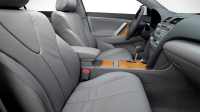 The car body is characterized by rounded forms, which allowed to reduce the aerodynamic drag. Standard enamels and metallic paint were used to paint the panels, and the paint layer is damaged by small stones. The metal was pre-galvanized and coated with a primer that prevents corrosion. Salt and sand can accumulate in hidden cavities and cause deterioration of parts. Plastic trim elements (bumpers, door handles and mirror housings) are painted in the vehicle's primary color.
The car body is characterized by rounded forms, which allowed to reduce the aerodynamic drag. Standard enamels and metallic paint were used to paint the panels, and the paint layer is damaged by small stones. The metal was pre-galvanized and coated with a primer that prevents corrosion. Salt and sand can accumulate in hidden cavities and cause deterioration of parts. Plastic trim elements (bumpers, door handles and mirror housings) are painted in the vehicle's primary color.
Interior trim is made of foam and hard plastic, with interior elements of American cars inferior in quality to those of cars for the European market.
The seats are upholstered in fabric or leather, which begins to crack due to natural aging. The steering wheel has leather covering, in expensive modifications the details, imitating wood, are used. In front of the driver is an analog instrument cluster, the central part of the panel contains a head multimedia device and climate control unit.
The front seats are adjustable by distance from the engine shield and the angle of the backrest, with height adjustment of the cushion and lumbar support adjustment.
Some of the machines are equipped with electric adjustment drives with position memory. The backrests and seat bases are flat, with little side support. The steering column is equipped with a standard angle and reach adjustment mechanism, and there is an armrest between the front seats with a hinged lid and an internal storage box for small items.
Car Features
The Camry 40 cars came with several types of engines and transmissions. The front suspension is equipped with McPherson struts, while a multilever arrangement is used at the rear. The design of the rear suspension allows the installation of a gearbox, all-wheel drive versions were produced in limited quantities.
Maximum speed of the car, equipped with 277-horsepower motor, reaches 230 km/h, up to 100 km/h car accelerates in 7.4 seconds.
Types of engines and transmissions
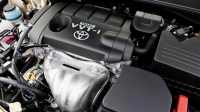 The Toyota 40 used gasoline engines 2AZ-FE (inline configuration) and 2GR-FE (6 cylinders, V-block), which developed 167 and 277 hp. For the North American and Japanese market, the original 149-horsepower 4-cylinder engine 2AZ-FXE was produced, designed to run as a hybrid power unit (with 41 hp electric motor). The units are equipped with a variable valve timing system to stabilize the torque curve and reduce fuel consumption.
The Toyota 40 used gasoline engines 2AZ-FE (inline configuration) and 2GR-FE (6 cylinders, V-block), which developed 167 and 277 hp. For the North American and Japanese market, the original 149-horsepower 4-cylinder engine 2AZ-FXE was produced, designed to run as a hybrid power unit (with 41 hp electric motor). The units are equipped with a variable valve timing system to stabilize the torque curve and reduce fuel consumption.
Brake system
The Toyota Camry XV40 uses a hydraulic dual-circuit diagonal braking system with disc mechanisms. An ABS+ESP anti-lock braking system is fitted as standard. The standard equipment includes a traction control system TCS, which prevents slipping of the drive wheels during acceleration on slippery road surfaces. The parking brake is lever-operated, mounted in the vehicle's interior, with a separate drum in the rear disc mechanisms.
Transmission
Several types of transmissions were used on the cars:
The version with the 2.4L engine was equipped with the E351 5-speed manual transmission;
for the 2.4-liter engine a 5-speed hydromechanical U250E/U151E series transmission was available;
versions with a 3.5-liter V-twin were supplied only with a 6-speed automatic U660E gearbox;
V-belt variator e-CVT P311 was used on the trucks with hybrid powertrain;
In small series modification with all-wheel drive system the U241E automatic transmission was used.
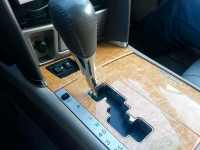 The power unit is installed in the engine compartment transversely, the torque is transmitted to the front wheels by half axles with articulated joints. The gear change is made with a lever located on the tunnel inside the cabin. Automatic transmissions do not support the manual shift algorithm, additional modes of operation are provided (for example, for operation on snowy roads).
The power unit is installed in the engine compartment transversely, the torque is transmitted to the front wheels by half axles with articulated joints. The gear change is made with a lever located on the tunnel inside the cabin. Automatic transmissions do not support the manual shift algorithm, additional modes of operation are provided (for example, for operation on snowy roads).
Interior electronics
The car provides the ability to install up to 6 airbags (front, side and curtain airbags). The market offered cars with automatic 2-zone climate control and CD player. There is an on-board computer with an LCD screen in the dashboard. Head unit is equipped with a monochrome display. After 2009, a multimedia center with a color display, navigation unit and support for wireless Bluetooth (optional) is available.
Security in case of theft
Standard equipment includes an immobilizer with an identification chip located in the key head. Provides for the installation of regular alarms, but the control units are located in standard locations, it takes no more than 10-15 minutes to hijack a car by professionals. For example, the immobilizer has an emergency algorithm (designed for the loss of the key), which allows you to move at low speed. The intruder needs to drive the car a short distance, and then change the engine controller (located in a niche under the glove compartment).
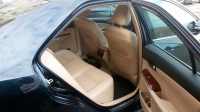 Camry XV40 owners have installed additional security features on their cars:
Camry XV40 owners have installed additional security features on their cars:
mechanical door and steering locks;
Transfer of regular blocks to other places;
Glass coating with armored film, not allowing an intruder to get into the cabin;
Alarm systems with GPS unit and additional relays, hidden in the harnesses of regular wiring (with wireless control).
Differences of restyling
In early 2009, Toyota made standard upgrades to the car as part of the model's life cycle. The dimensions and outlines of the body remained unchanged, as did the specifications of the engines used. The restyling led to changes in the design of the radiator grille and front bumper, in the bodies of the rear-view mirrors appeared direction indicator repeaters. Expensive versions received a chrome plaque on the trunk lid. There is a larger display diagonal of the radio and redesigned plates on the dashboard.
Advantages and disadvantages according to the owners
Reviews left by the owners allow you to conclude about the reliability of the car design. For example, the brake mechanisms require regular cleaning and lubrication of the caliper guides. Disks can pass up to 200 thousand km, but if the elements are constantly overheated (applies to cars with a 3.5-liter motor), the resource drops by 5-6 times. Handbrake requires periodic retightening of cables, for replacement of parts it is necessary to disassemble the center console trim.
The manufacturer did not provide for the XV40 a station wagon body, but the strength of the suspension is not enough for a sedan. For example, the angle of the front wheels is disturbed after several trips on rough roads. The service life of ball bearings and shock absorbers does not exceed 150 thousand km, transverse stabilizer struts break in 40-50 thousand km.
The steering does not need any intervention, the fluid leaks from the booster occur at mileages over 300 thousand km. There is a knocking of slotted joints in steering tube, which does not affect steering accuracy. 2-mass flywheels are not used in design of engines, hydromechanical transmission requires regular replacement of working fluid and filter. Aggressive driving can burn out friction packs and damage bearings. Manual transmission control rocker is broken, it is recommended to change shift cables after 150-200 thousand km run. The disadvantages are the radiators of the cooling system, which get rotten after 8-10 years of operation. The service life of the piston group of 2AZ and 2GR engines exceeds 350,000 km.
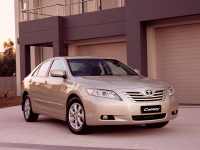

-rear-and-front-view-camera-6.png)

